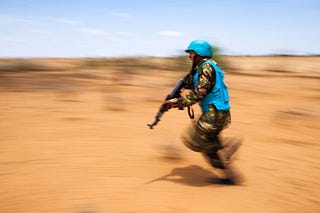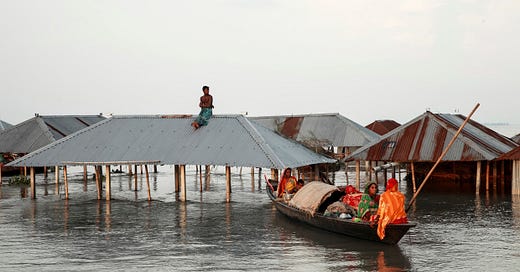
Discover more from Moving climate: a newsletter on migration and climate change
A “biblical exodus” is not a helpful way to talk about climate driven migration
Apocalyptic language is more likely to bring us walls, fences and detention than the humane responses we need.
This week António Guterres the secretary general of the UN said that climate change would create “a mass exodus” on a “biblical scale” and that this migration could unleash a “torrent of trouble”.

Climate change does have the power to reshape patterns of human movement across the world. It already is. Rising temperatures are already driving more extreme disasters, which are leading to new patterns of movement.
The way we talk about the connections between climate change and human movement has been a subject of deep controversy - and with good reason. The language and stories we tell about these connections have the power to shape the global response.
The language used to describe people who are on the move also has the power to shape their experience - whether they are treated humanely or with violence, whether they are welcomed or met with hostility.
Talking about the connections between climate and migration carries a responsibility. It requires using language which promotes humane and welcoming treatment. It means picking words and phrases that move us closer to just and equitable responses.
The idea of a mass exodus suggests huge numbers of people moving suddenly and all together. It conjures images of millions of people moving on foot and crossing continents. The reality of climate driven migration is rather different.
Many people engage in temporary and seasonal migration as farming becomes harder. But they tend to move from rural areas to nearby cities to find work. Very often they use migration as temporary measure - moving back and forth as droughts come and go.
In response to sudden climate related events like typhoons or flooding people usually move the shortest distance to find safety. Yes, millions of people move. But most people return home in the aftermath of the disaster to rebuild.
People often use existing legal migration options to move out of harm's way. For example many people use existing work and education visas to find opportunities that take them out of areas that are becoming harder to live in.
Climate change can also trap people as well as forcing them to move. As climate extremes erode livelihoods people often find themselves without the resources they need to migrate. Climate impacts sometimes reduce migration.
There are always multiple factors that lead to someone’s movement. Climate change is rarely the sole cause. Existing conflict, histories of colonisation and oppression, lack of investment in resilient infrastructure can all combine with climate impacts to make someone move.
The point is, these patterns of movement do not necessarily look like a “mass exodus”. And while a lot of people are on the move, it’s not clear what describing it as “biblical” really helps anyone understand the complexity of the situation.
Phrases like “mass”, “biblical”, “exodus” and “torrent” also speak powerfully to people and politicians in the global north who are already hostile to migrants and refugees. These phrases tap into existing fears about future migration caused by climate change.
These narratives are likely to supercharge a set of policy responses based on preventing human movement through border security and militarization. This is already the chosen approach of most northern governments.
The EU, US and Australia are already investing heavily in border security. They are increasingly militarising their border zones. They are deliberately making approaching and crossing their border more deadly as a form of deterrence.
Pre-emptive detention is increasingly the norm for refugees and migrants. Governments are also investing heavily in increasingly sophisticated tech that allows them to monitor and track refugees and migrants as they approach and cross their borders.
This approach is driven (in part) by a fear of future patterns of large scale migration. These fears are often fuelled by the language some use to talk about future patterns of human movement. Words like “biblical”, “exodus” and “torrent” are not helpful.
These phrases are often only intended to convey urgency. But they have meanings and consequences that go far beyond that. They have the power to shape the political response to climate-driven migration in potentially disastrous ways.
The United Nations has usually been careful and cautious about how it describes the connection between climate change and migration. Which is why it is surprising to hear Guterres using such dramatic language.
The UN’s own university carried out much of the early pioneering work on the connections between climate, drought and migration. They found that people usually moved short distances and mostly moved internally.
The UN Migration Agency promotes migration as part of the solution to climate change. They have often made the case for using carefully planned and facilitated migration as a way for people to adapt to the worst impacts of climate change
UNICEF has explored how migrant children fleeing climate change can be protected by creating new safe legal options for people to migrate.
In all of these activities the UN has adopted consistent language and messaging about climate and migration. Language that conjures images of apocalyptic scenarios is avoided. Statistics about future migration are treated carefully, migration linked to climate is accurately characterised as usually internal and short distance. The complexity of the connections is recognised. And the diversity of different forms of movement is recognised.
This is a stark contrast to Guterres’ language of a biblical exodus. This matters. Dramatic language might get the headlines. But more sensitive language is likely to bring about the just and humane response we need.








